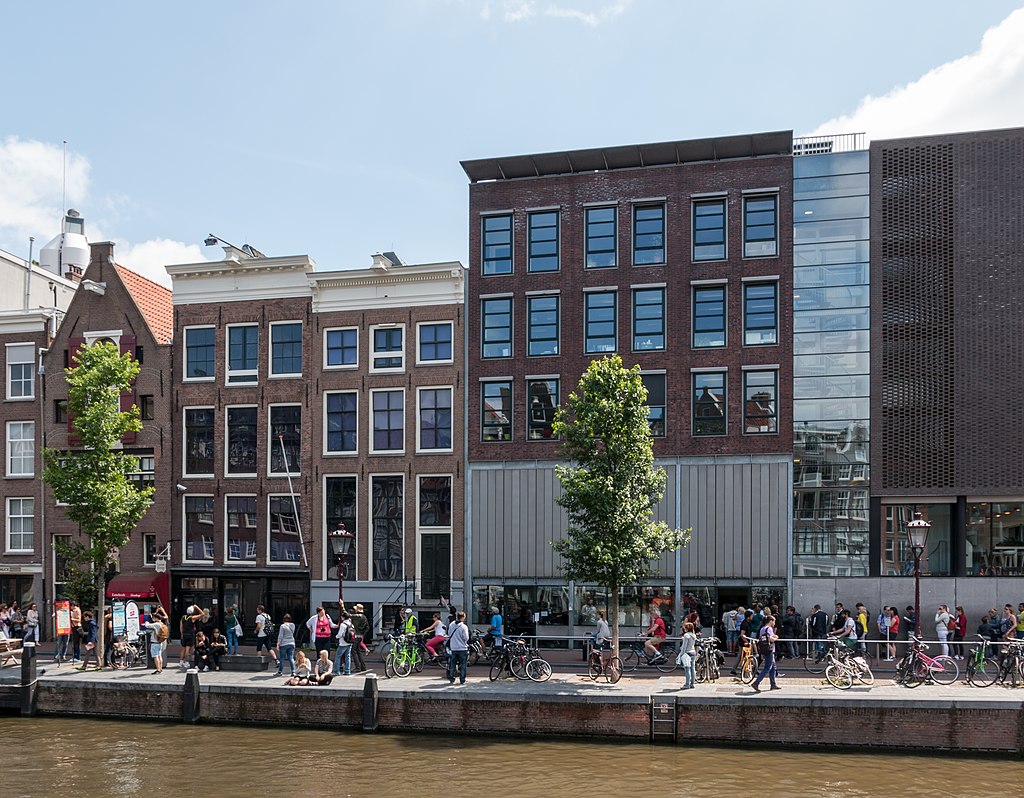Anne Frank
Grades 4+
 6 July 1942. Fourteen-year-old Anne Frank sat in a corner with (1) her diary in her hands, feeling the familiar texture of the cover. She was in the attic of the house in Amsterdam where she had been living in hiding for the past two years and thirty-five days.
6 July 1942. Fourteen-year-old Anne Frank sat in a corner with (1) her diary in her hands, feeling the familiar texture of the cover. She was in the attic of the house in Amsterdam where she had been living in hiding for the past two years and thirty-five days.
Her mind wandered as she thought of all the things she had seen and experienced during her time in hiding. She had gone from a carefree, happy girl, to a young woman who had seen the Nazis marching in the streets and her fellow Jews being rounded up at gunpoint and forced like cattle into trucks.
She opened her diary and began to read. She mainly had written about the two families and married man who lived in hiding with her. She also had written about how she felt, how the war had impacted her life and how she was struggling to make sense of it. She had found at least some comfort in the words she was putting onto the page. She was able to express her feelings in a way that she couldn’t do with anyone else. Writing in her journal was a way for (2) her to process her thoughts and feelings, and to make sense of the world around her.
 The Franks had moved into the attic hiding place two years ago, in (3) what was called the Achterhuis, or the annex house. Her family had fled Germany and come here to Amsterdam in the hope of escaping the Nazis. But the war had followed her. Like a cancer, she thought.
The Franks had moved into the attic hiding place two years ago, in (3) what was called the Achterhuis, or the annex house. Her family had fled Germany and come here to Amsterdam in the hope of escaping the Nazis. But the war had followed her. Like a cancer, she thought.
She sighed and closed the diary. She wrote in it every day. But not this day, she thought. She did not know why, but she felt (4) herself incapable of expressing herself in words today.
The secret door slammed open, and Nazi Gestapo stormed in. Anne dropped the diary as she and her family were arrested.
What is our crime? she wanted to cry out. What is (5) our crime?
But she already knew the answer.
They were Juden – Jews.
(6) Which was (7) no answer at all.
Because it was a world that belonged to the Nazis. It was a world without answers.
Once at the Gestapo headquarters, Anne felt scared and alone as she watched (8) her family suffer through the questioning. She tried to remain strong, but she could not help the tears (9) that streamed down her face.
The following morning, the Franks were loaded onto a train, into a boxcar usually meant for farm animals. Squeezed among perhaps a hundred others, Anne watched the world pass by through the slatted walls. The world of the Netherlands, with its peaceful farmland and plots of flowers floated past (10) her. How could such beauty surround such terror. She was numb with fear. She wanted to sit down, hug (11) her knees, and pretend that none of this was real. But there was (12) no way to sit down. The boxcar was too crammed full of humans the Nazis thought of as animals.
∗
Anne never returned to Amsterdam. Only her father did. He was the only one of the Frank family and their friends (13) who made it out of the Nazi camps alive. Anne survived being gassed when she reached the notorious Auschwitz Concentration Camp – where up to 25,000 people were murdered every day – because she had turned 15 since being arrested. Anyone under the age of 15 was immediately executed.
The last time Anne was seen by someone who knew her and survived the camps, she was so malnourished (14) that her body was almost (15) that of a skeleton. She had on an old shawl and a blanket – her clothes were so filled with lice (16) that she could not wear them.
Most of the people from the attic survived until just as before the war ended. (17) What a terrible irony! One died four days after the war was over. Anne survived until February, 1945, and probably died of typhus fever. It killed 17,000 people in the camp where she was. At least, she perhaps thought as she slipped in and out of delirium as her life ebbed away, I have cheated the Nazis. Those (18) whose gas chambers are a source of pride.
After the war, her father returned to the hiding place, looking for anything (19) that remained of his family. Miraculously, no one had ransacked everything the Franks and their friends left behind. He found Anne’s diary.
Now, decades later, Anne is an everlasting symbol of innocence, hope, and optimism. What is now known as The Anne Frank House, where she was in hiding, is the most popular tourist attraction in the Netherlands. In death, she continues to receive thousands of letters from children all over the world, expressing love and admiration for (20) her. Additionally, she has an unofficial page on Facebook, where her fans can connect and pay tribute to her memory.
Anne Frank Activity 1
Determine if each underlined word above is a pronoun, determiner, or lesser conjunction.